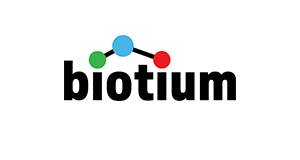CD68 (Macrophage Marker) (C68/2908R), CF740 conjugate, 0.1mg/mL
CD68 (Macrophage Marker) (C68/2908R), CF740 conjugate, 0.1mg/mL
Artikelnummer
BTMBNC742908-100
Verpackungseinheit
100 uL
Hersteller
Biotium
Verfügbarkeit:
wird geladen...
Preis wird geladen...
Description: This antibody recognizes a glycoprotein of 110 kDa, which is identified as CD68. It is important for identifying macrophages in tissue sections. It stains macrophages in a wide variety of human tissues, including Kupffer cells and macrophages in the red pulp of the spleen, in lamina propria of the gut, in lung alveoli, and in bone marrow. It reacts with myeloid precursors and peripheral blood granulocytes. It also reacts with plasmacytoid T cells, which are supposed to be of monocyte/macrophage origin. It shows strong granular cytoplasmic staining of chronic and acute myeloid leukemia and also reacts with rare cases of true histiocytic neoplasia. Lymphomas are negative or show few granules.Primary antibodies are available purified, or with a selection of fluorescent CF® Dyes and other labels. CF® Dyes offer exceptional brightness and photostability. Note: Conjugates of blue fluorescent dyes like CF®405S and CF®405M are not recommended for detecting low abundance targets, because blue dyes have lower fluorescence and can give higher non-specific background than other dye colors.
Product origin: Animal - Oryctolagus cuniculus (domestic rabbit), Bos taurus (bovine)
Conjugate: CF740
Concentration: 0.1 mg/mL
Storage buffer: PBS, 0.1% rBSA, 0.05% azide
Clone: C68/2908R
Immunogen: Recombinant full-length human LAMP4 protein
Antibody Reactivity: CD68
Entrez Gene ID: 968
Z-Antibody Applications: IHC, FFPE (verified)/WB (verified)
Verified AB Applications: IHC (FFPE) (verified)/WB (verified)
Antibody Application Notes: Higher concentration may be required for direct detection using primary antibody conjugates than for indirect detection with secondary antibody/Immunohistology (formalin): 0.5-1 ug/mL for 30 minutes at RT/Staining of formalin-fixed tissues is enhanced by boiling tissue sections in 10 mM citrate buffer pH 6.0 for 10-20 minutes followed by cooling at RT for 20 minutes/Optimal dilution for a specific application should be determined by user
Product origin: Animal - Oryctolagus cuniculus (domestic rabbit), Bos taurus (bovine)
Conjugate: CF740
Concentration: 0.1 mg/mL
Storage buffer: PBS, 0.1% rBSA, 0.05% azide
Clone: C68/2908R
Immunogen: Recombinant full-length human LAMP4 protein
Antibody Reactivity: CD68
Entrez Gene ID: 968
Z-Antibody Applications: IHC, FFPE (verified)/WB (verified)
Verified AB Applications: IHC (FFPE) (verified)/WB (verified)
Antibody Application Notes: Higher concentration may be required for direct detection using primary antibody conjugates than for indirect detection with secondary antibody/Immunohistology (formalin): 0.5-1 ug/mL for 30 minutes at RT/Staining of formalin-fixed tissues is enhanced by boiling tissue sections in 10 mM citrate buffer pH 6.0 for 10-20 minutes followed by cooling at RT for 20 minutes/Optimal dilution for a specific application should be determined by user
| Artikelnummer | BTMBNC742908-100 |
|---|---|
| Hersteller | Biotium |
| Hersteller Artikelnummer | BNC742908-100 |
| Verpackungseinheit | 100 uL |
| Mengeneinheit | STK |
| Reaktivität | Human |
| Klonalität | Recombinant |
| Methode | Western Blotting, Immunohistochemistry |
| Isotyp | IgG |
| Wirt | Rabbit |
| Konjugat | Conjugated, CF740 |
| Produktinformation (PDF) | Download |
| MSDS (PDF) | Download |

 English
English







